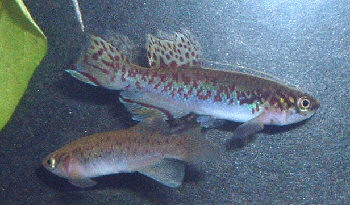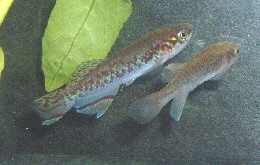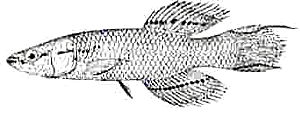Fundulopanchax gularis (Boulenger 1902)


Taken at the 2004 SKS convention.
| Meaning of Name |
From the Latin gula meaning striped which refers to the maroon throat markings. (Also seen on females). | ||
| First Description |
Boulenger G.A. 1901. (Fundulus
gularis).
Line drawing used by Boulenger in the original description. | ||
| Size |
7 cm. | ||
| Meristics |
| ||
| Karyotype |
n = 16, A = 16 (Scheel 1968, 1975). | ||
| Sub-Genus |
Gularopanchax | ||
| Group |
| ||
| Synonyms |
The sp. described as beauforti is a little confusing & some authors have placed them in A.(Raddaella) batesii. The fish was described from a single female which is now in bad condition. It is now difficult to study. |
||
|
Populations
|
| ||
| Type Locality |
Agberi, on the Nun River, situated in the west of the Niger Delta. They were caught in 'shallow creeks & flooded Yam plantations'. | ||
| Distribution |
Niger & Upper Lobo River drainages eastwards to southwest Nigeria & southern Benin. Sympatric sp. include Fp.sjoestedti, Fp.arnoldi, Fp.filamentosum,A.multicolor, A.calliurum. | ||
| Habitat |
Humid coastal rainforest marshes, raffia swamps & other swampy areas of small streams & floodplains. Scheel in ROTOW 1 gives 2 photos on page 245. Kluge collected both forms in the same pool & stated that only one form was dominant at any one time. I would really like to put these photos in here but copyright prevents it. | ||
| Distinguishing Characteristics |
Scheel in ROTOW 1 reports that males can be distinguished by a 'very dark red marking on the throat'. Boulenger, incidentally used this marking in describing the species In the 1980's much confusion reigned over ditinguishing between fallax, deltaense & gulare. Fp.fallax can grow larger. Generally fallax has finer spots on the body. gularis tend to have larger spots forming a near solid line through the upper centre of the body. The caudal fin has the same characteristic 'split' in both species (amieti also has this 'split') where the upper half is spotted & the lower half is clear. fallax has many fine spots (lines in some populations, Malende). Also the lower edge of this fin tends to have an outer marginal band of yellow with a sub-marginal band of red. In fallax this outer marginal band can either not be present, present as a thin band or present as a spotted pattern. Another method of seperating the species is in the pectoral fins. gularis tends to be clear in many populations with a feint outer marginal band in some populations (Ijebu Ode). fallax tends to have a marginal & a sub-marginal band in these fins. The obvious distinguishing marking which seperated deltaensis from gularis was the clear anal fin which carried no spot or line. | ||
| Colour/Pattern Variability | Regarded as high. | ||
| History |
Boulenger described this sp. from 16 specimens taken at Agberi in the western area of the Niger Delta. Pellegrin, in 1907, reports a population from the Ntem River at the southernmost part of Cameroon. These may have come from the area near the mouth of this river as this is very swampy. These early collections were placed closest to Fp.sjoestedti. Imported into Europe in 1905 & 1907. The first import is not certain. Arnold reports them being in Germany in 1907 but it has been reported that they were imported into Germany in 1905. Boulenger identified both imports as being gulare but Arnold considered them sufficiently distinct from each other to call the 1905 import 'gulare var.A(blue)' & the 1907 import 'gulare var.B (yellow)'. See also Fp.sjoestedti. This 1907 import was said to have been collected from the Niger Delta area & were reportedly feeble with there being 'not reproduced'. However, in 1911 aquarists in Germany reported breeding them. Arnold also reported that both blue & yellow forms had been crossed in Vienna. Scheel had his doubts about this crossing. In 1913 Krüger reported receiving preserved individuals of this species from Schwab, a missionary based in Ebolowa, southern Cameroon. These were reportedly collected in brackish water. These may have been a similar form to Pellegrin's. Pellegrin reported this species from Nyabessan in 1929. Boulenger gives the following collectors / locations in his 1915 Catalogue.
In 1955 they were imported into Holland. Scheel had fish from this import along with Fp.filamentosus. The males of the Fp.gularis died en route to Copenhagen. Clausen collected them at Ago-Iwoye, close to Ijebu Ode, southwest Nigeria. A live male from this collection was given to Scheel who crossed it with a gardneri Akure female. He reported that this crossing was 'very viable & almost sterile in backcrossings'. In 1961 another import containing Fp.gularis
reached Holland. These were photographed by Nieuwenhuizen & de Looze. History of the synonym Fundulus beauforti (non Ahl 1924) Klee & Turner 1962 In 1962 Klee & Turner identified
some aquarium kept fish as beauforti.
These were later identified as Fp.gularis | ||
| Breeding Notes |
Two
- three females per male is the best ratio. Use a larger tank for breeding with
either bottom mops or a layer of peat. This peat can be taken out every fortnight
& dried for around 6 weeks. Reports would suggest they can be ready to hatch
between 5 & 9 weeks. Other reports suggest a minimum of 8 weeks. In this set
up 100 eggs may be found in a single day's spawning. Sterba in Freshwater Fishes reported males to be very quarrelsome. Young hatch in 3-8 weeks, usually after 5 weeks. Jaroslav Kadlec in BKA newsletter No.397, October
1998 reported breeding them in very soft water. He used distilled water
with MGS04 to give a hardness of 0·3-0·8. Tank capacity
5-8 litres with a layer of peat 2 cm deep on the base. Conditioned fish
- 1 male & 2-3 females are put in the tank for 3-8 hours. After
this time the fish are removed to seperate tanks & well fed for
2-4 days. After 3-4 spawning sessions the peat is removed, dried on
newspapers & bagged. | ||
| Diameter of Egg |
1mm. |
||
| Remarks |
One of the more aggressive sp. of Fundulopanchax. Velvet is a particular killer. Not a sp. for the beginner. |
